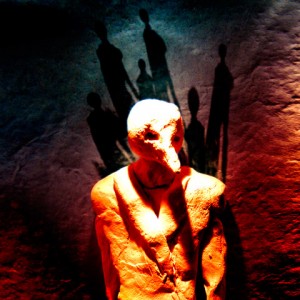As a writer and reviewer, I am constantly confronted by my own limitations. We seek to convey a feeling in words, and not even words expressed in the air, but on screen or on paper. You don’t get to hear tone of voice, or see small tell-tale signs on the face, or other aspects of body language to carry the message across. You get the words, and that’s it.
This requires us to occasionally lean on the same small bunch of words over and over because we know they work. We also know it is a lazy practice. We’ll use the word “glorious” because it articulates how a song, or just a moment or aspect of a song, makes us feel, but there’s a good chance you, the reader/listener, will not get the same reaction. Therefore, you will not share that same feeling of glory and will wonder why we are so bad at exaggeration.
We might also use the word “haunting,” as in, “The song has a haunting refrain,” or “it has a haunting melody,” when what we really mean is that the song kind of sounds spooky, or maybe contains an earworm we cannot shake…for a few minutes. But still, we’ll whip that haunted horse long after it is dead, and sometimes more for good measure. We can’t have those spectral Clydesdales rising from the grave, now can we?
The real issue here is not that we are afraid of sounding hacky or lazy, but that when we really want to express something as “haunting,” we’ve now expended all our firepower on, what, a pop song that will vanish into the ether six months from now? That’s not haunting. Haunting sticks with you for the long haul. It gives you that indescribable sense every time you come back into contact with it. True to the word, something that is haunting should rightly haunt you.

With that in mind, and for my sins, I can vaguely recall a dozen times I misappropriated the word, mostly because I wasn’t ready to find a better, more accurate descriptor.
This is a long walk to get to my central point. If you need a truer definition of when a piece of music is actually haunting or is just eerily sticky, look no further than 2012’s March of Ghosts from Oslo, Norway’s Gazpacho. Presumably, the prog rock band got their name from the song by Marillion, off their 1995 record Afraid of Sunlight and that’s not unmerited speculation. The band’s earliest incarnations, as well as Marillion’s tacit support, provide the necessary link, but Gazpacho has developed into its own thing since then (as any good band must). Starting with March of Ghosts and continuing on through 2018’s Soyuz, the band has fused a sensibility of pop (known in these circles a neo-prog) with folk and hard rock with the kind of “shadows on the wall” storytelling more akin to metal bands. 2014’s Demon was miracle of construction, largely eschewing traditional verse-chorus-verse-bridge-chorus for something flowing and darkly transforming. It is mostly easy on the ear but it plants little bombs in the brain that go off when one least expects it. It is a ride, and one that leads you to the other side, but not necessarily to a brighter side.
March of Ghosts is, by that measure, less experimental but hardly lightweight. In this, one is reminded of a story arc from the writer Neil Gaiman for the comic series The Sandman. In it, a group of figures are locked in a pub (I think due to inclement weather, but it has been some time since I’ve read this) and they recount tales of woe, indiscretion, and the otherworldly, sometimes referencing the series’ title character The Sandman, or rather, the Lord of Dream.
March of Ghosts is not based on that story arc, but the central conceit of a character being presented with a series of short narratives from the unfortunate and/or misbegotten, bears similarities. (Both owe a debt to The Canterbury Tales, although the tone is far, far different.)
The “march of ghosts” is, in the album’s context, a man who hears the tales being told by a series of ghosts, one after another. Connected in theme but not in structure, the songs may be more conventional, but their affect on the listener is not. It is, in fact, haunting.
I present as evidence two standout tracks, “Mary Celeste” and “What Did I Do?” We’ll start with the second one first, which Wikipedia has described as:
“(A) song that’s based around the story of the English writer P. G. Wodehouse, who was accused of treason after a series of broadcasts he did on German radio during World War II. He was interned as a foreign national by the Germans and spent some time in prison camp before finally being released at 60.”

To get a sense of Wodehouse’s material, he was responsible for the series of books with the characters Jeeves and Wooster, later adapted for television with Stephen Fry and Hugh Laurie, playing a long-suffering valet who keeps his boss, the slightly dotty upper-class man-about-town from making increasingly bad decisions. The caring Jeeves is always pulling affable doofus Wooster out of the most awkward situations. In other words, it’s hard to know what Wodehouse’s deep, internalized intentions were, but he hardly came off as a dark and tortured propagandist in his work.
More from the Wikipedia entry: “After (Wodehouse) was released he stayed for some time at a country estate where he was informed of what crimes the Nazis were guilty of and how impossibly stupid it was to agree to broadcast on their radio. It is his ghost we hear sitting on the porch listening to the gramophone recordings of the broadcasts trying to understand why these simple funny narratives had caused such an uproar.”
I cannot pretend to understand what it would be like to accidentally be charged with something so heinous as giving even remote succor to fascism or authoritarianism. The song is an imagining, but it is equally hard to know what was in Wodehouse’s heart, so we give him the benefit of the doubt.
That said, everyone has been in a situation where what they said in the midst of a moment, or what they did in a similar moment, was either misinterpreted or was correctly interpreted but the effort itself was not intended that way. We’ve all accidentally been harmful, and only later been told where the harm was, and felt ashamed for both the act and for the foolishness that was blinding.
The way the band, with vocalist Jan Henrik Ohme at the top, convey this narrative is striking. With rich vocal harmonies almost pleading for clarification, more than sympathy or forgiveness, he croons “What have I done” and “What did I do,” in the same way that each of us has thought it. Still, when we have reached that moment when the question can be uttered, it’s too late. The damage is done. When I hear this song, I am reminded of a thousand times when I’ve stuck my foot in my mouth (among other orifices) and that sense of being trapped by fate and layers of ignorance stays with me for days, and may adhere themselves to me my whole life long.
The other song, “Mary Celeste,” is not about a woman, but about a boat, an American merchant ship, found adrift and deserted in the Atlantic Ocean, off the Azores Islands, on December 5, 1872. Everything leading up to the moment of discovery indicated it was nearly a textbook example for sailing a ship – a steady captain, a confident and seasoned crew, the captain’s family, plenty of supplies, calm seas, lifeboats, and no reason why the boat should be found abandoned.
But it was. There were no signs of struggle or mutiny, no missing goods or treasures lost. The food was still in place. The sailing equipment was still present, and most strikingly, the lifeboats remained, but everyone on-board was gone. No bodies were recovered, but still, the only conclusion anyone could make was this was a murder-suicide and everyone jumped to their deaths into the water, likely eaten by sharks. As you can imagine, in 1872 there weren’t the means to do an investigation of the waters beneath the boat, and so the legend of the vanishing crew and family aboard became almost mythological.
The song, while found in the standard rock structure, deals with the conceit of stories that cannot be told and truths that cannot be verified because all those who could have done so are mysteriously unavailable. Was the captain, Benjamin Briggs, at fault? Was the ship boarded by pirates and, if so, why were there no signs of a fight? More pointedly, why was nothing taken? That would have been the primary motivation of a pirate, after all.
Such is the situation will all the songs on March of Ghosts. Even when the tunes themselves lean toward recognizable standards, it’s the ideas that get stuck in your head. You feel, when listening to it, like you yourself are conversing with the supernatural, but more often you’re confronted with souls that have big issues they are no longer capable of doing anything about. They’re lost to eternity to be stuck with their regrets, their mistakes, the things they should have said but didn’t, and the things they did say, but shouldn’t have. These are the damned who did, and the damned who didn’t.
If you need a better illustration of what is really, genuinely “haunting,” I cannot think of a better one.

